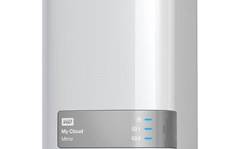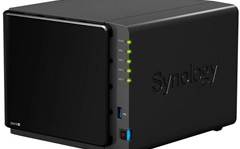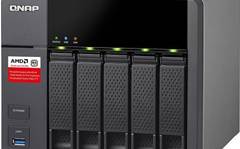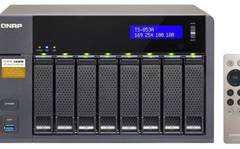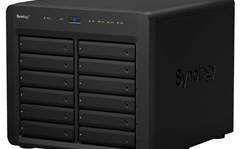Qnap's versatile multi-bay NAS system has the configuration and price options to suit a wide range of businesses.
Businesses looking for a desktop NAS appliance that does it all will like Qnap’s TVS-1282. Choice is king as the family comprises seven models, each offering different combinations of Intel processors, RAM and power supplies.
We reviewed the flagship TVS-1282-i7-64G-450W which packs in a 3.4GHz quad-core Intel Core i7-6700 processor, 64GB of DDR4 memory and a 450W power supply. If this is too much, other options include cheaper Core i3 and i5 processors, less memory and a 250W power supply.
The appliance has eight large form factor (LFF) and four small form factor (SFF) hot-swap SATA drive bays with room inside for two M.2 SATA solid state drives. There’s more as it sports three PCI-Express expansion slots with the inner one accepting full-length, full-width cards such as a GPGPU or a PCIe NMVe SSD (Intel’s P3700 models are certified).
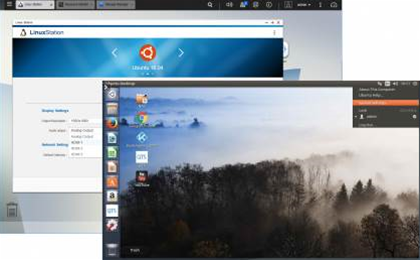
pipe it to one of the appliance’s HDMI ports.
Around the back are four Gigabit, four USB 3, multiple audio jacks, built-in speakers and three HDMI ports. The latter can be used to stream HD video or be teamed up with Qnap’s Linux and HD Station apps for desktop access via a local monitor, keyboard and mouse.
Expansion caution
Installation is simple with Qnap’s Qfinder on the case as it discovered the appliance and helped create a RAID5 storage pool with three 8TB Seagate NAS HDD drives. We chose a thin storage pool which brings NAS share and iSCSI LUN snapshots into play.
We wanted to run performance tests over 10-Gigabit (10GbE) but found an issue with the expansion slots when fitting an Emulex OCE11102-NT 10GbE card. The CPU has a dedicated blower fan and the mounting bracket directly opposite the two outer PCI-e slots restricts card lengths to 147mm.
The Emulex card is 167mm long so only fits in the inner PCI-e slot where it worked fine. Our Intel X520-SR2 10GbE fibre cards are short enough but no Intel adapters are supported at present.
QTS software
Qnap’s QTS 4.3 software is a major refresh which delivers plenty of new features and improvements to many existing apps.
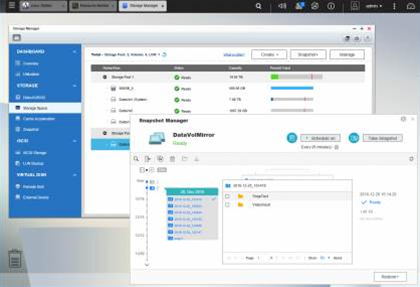
The TVS-1282 supports the Qtier app which migrates data blocks across up to three storage levels based on usage. Data migration tasks must be scheduled but the new Auto Schedule feature decides when to run these based on I/O activity.
Qnap’s Virtualisation Station always impresses as it allows the TVS-1282 to host virtual machines running just about any operating system you fancy. The new version has a more informative interface and now supports GPGPU pass-through for selected VMs.
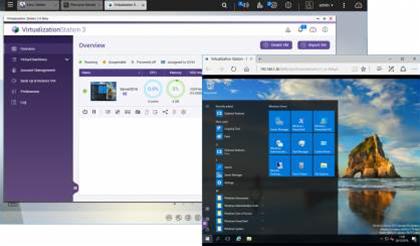
The desktop and Control Panel get a refresh while the new resource monitor offers a wealth of graphs and tables on hardware and storage utilisation. The new Qfiling app keeps your files in order as it can search for them using a wide range of criteria and copy or archive them to a different location.
Performance
To test performance, we used a Lenovo System x3550 M5 rack server running Windows Server 2012 R2 and equipped with an Emulex 10GBase-T adapter. Running Iometer on a share mapped over 10GbE, it reported fast raw read and write speeds of 9.2Gbits/sec and 8.4Gbits/sec.
Our real-world tests proved undemanding with copies of a 25GB test file returning read and write speeds of 4.6Gbits/sec and 3.7Gbits/sec. Backup operations are also fast as we secured a 22.4GB test folder with 10,500 small files to a share at 2.3Gbits/sec.
IP SAN (Internet Protocol storage area network) performance is nothing to sniff at either with Iometer reporting raw read and write speeds of 9Gbits/sec and 9.2Gbits/sec for a 500GB target. We created a dual 10GbE MPIO link to the target and saw Iometer read and write speeds ramp up to 17.5Gbits/sec and 16.2Gbits/sec.
Data protection
The main Storage Manager app is used to create snapshots for NAS shares and iSCSI LUNs and we could schedule them for as often as every five minutes. The Snapshot Manager gets a refresh in QTS 4.3 with the Timeline view making it even easier to locate snapshots and recover from them.
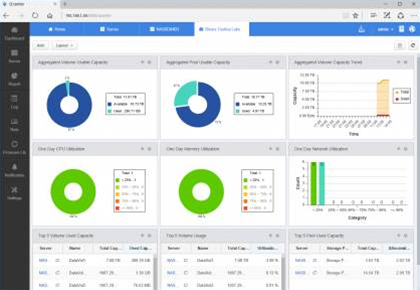
central console for managing all your Qnap appliances.
To restore data, we selected a snapshot and could recover it all using the Revert option, download selected folders or mount snapshots as shares and browse their files. Smart snapshots save storage space as the appliance only takes the next snapshot if the data has changed since the last one.
All local, remote, Rsync, and iSCSI LUN backups are managed by the Hybrid Backup Sync app. Load the Cloud Backup Sync feature and it adds facilities for managing backups to providers such as Amazon, Azure and Google Cloud Storage.
The app also handles off-site backup using RTRR (real-time remote replication) which runs one-way or two-way syncs between folders on local and remote Qnap NAS appliances. The Qsync Central app looks after Windows and Mac client backup by providing real-time, two-way folder syncing.
Pricing and conclusion
Apart from the size restrictions on the two outer PCI-Express slots, there’s little else to criticise the TVS-1282 for. It combines a wealth of storage permutations in a well-built chassis with a powerful and versatile hardware package.
Qnap’s data protection features make it a great backup repository and its virtualisation apps are unbeatable. It delivers top NAS and IP SAN performance while the new QTS 4.3 software will make a great NAS appliance even better.
It’s also pretty good value and suitable for a range of budgets. As mentioned above, the TVS-1282 comes in eight different configurations. Here they are, along with the price that we’ve seen each model selling for (without disks):
- TVS-1282-i3-8G: Intel Core i3-6100, 8GB DDR4 RAM, 250W power supply – from $2,585
- TVS-1282-i5-16G: Intel Core i5-6500, 16GB DDR4 RAM, 250W power supply – from $3,010
- TVS-1282-i5-16G-450W – Intel Core i5-6500, 16GB DDR4 RAM, 450W power supply – from $3,568
- TVS-1282-i7-32G: Intel Core i7-6700, 32GB DDR4 RAM, 250W power supply – from $3,971
- TVS-1282-i7-64G: Intel Core i7-6700, 64GB DDR4 RAM, 250W power supply – from $4,319
- TVS-1282-i7-32G-450W: Intel Core i7-6700, 32GB DDR4 RAM, 450W power supply – from $4,375
- TVS-1282-i7-64G-450W: Intel Core i7-6700, 64GB DDR4 RAM, 450W power supply – from $4,804 (or $5,572 with 8 x Seagate 1TB IronWolf NAS drives).
This article originally appeared at IT Pro.



